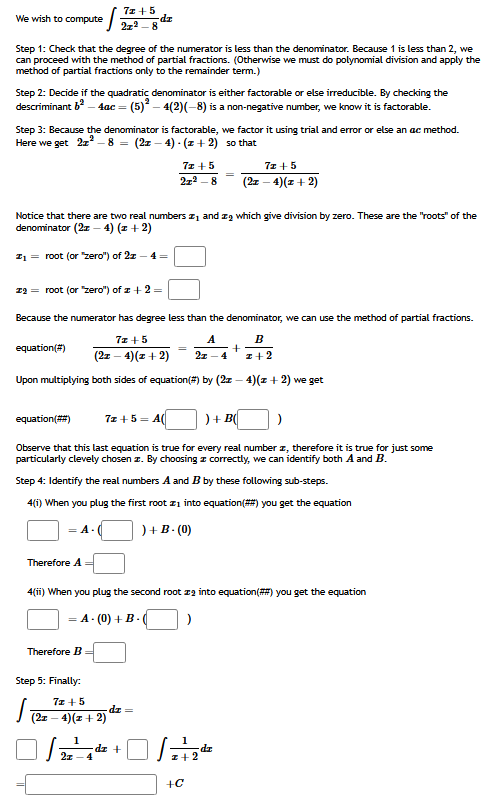Home /
Expert Answers /
Algebra /
we-wish-to-compute-int-7x-5-2x-2-8-dx-step-1-check-that-the-degree-of-the-numerator-is-less-t-pa170
(Solved): We wish to compute \int (7x+5)/(2x^(2)-8)dx Step 1: Check that the degree of the numerator is less t ...
We wish to compute \int (7x+5)/(2x^(2)-8)dx
Step 1: Check that the degree of the numerator is less than the denominator. Because 1 is less than 2 , we
can proceed with the method of partial fractions. (Otherwise we must do polynomial division and apply the
method of partial fractions only to the remainder term.)
Step 2: Decide if the quadratic denominator is either factorable or else irreducible. By checking the
descriminant b^(2)-4ac=(5)^(2)-4(2)(-8) is a non-negative number, we know it is factorable.
Step 3: Because the denominator is factorable, we factor it using trial and error or else an ac method.
Here we get 2x^(2)-8=(2x-4)*(x+2) so that
(7x+5)/(2x^(2)-8)=(7x+5)/((2x-4)(x+2))
Notice that there are two real numbers x_(1) and x_(2) which give division by zero. These are the "roots" of the
denominator (2x-4)(x+2)
x_(1)= root (or zero) of 2x-4=
x_(2)=\root( or zero)( o)f x+2=
Because the numerator has degree less than the denominator, we can use the method of partial fractions.
equation(()/()#) ,(7x+5)/((2x-4)(x+2))=(A)/(2x-4)+(B)/(x+2)
Upon multiplying both sides of equation(#) by (2x-4)(x+2) we get
equation(##) ,7x+5=A(,)+B(,)
Observe that this last equation is true for every real number x, therefore it is true for just some
particularly clevely chosen x. By choosing x correctly, we can identify both A and B.
Step 4: Identify the real numbers A and B by these following sub-steps.
4(i) When you plug the first root x_(1) into equation(##) you get the equation
=A*1,
Therefore A=
4(ii) When you plug the second root x_(2) into equation(##) you get the equation
=A*(0)+B*(,)
Therefore B=
Step 5: Finally:
\int (7x+5)/((2x-4)(x+2))dx=,
\int (1)/(2x-4)dx+,\int (1)/(x+2)dx
=,+C